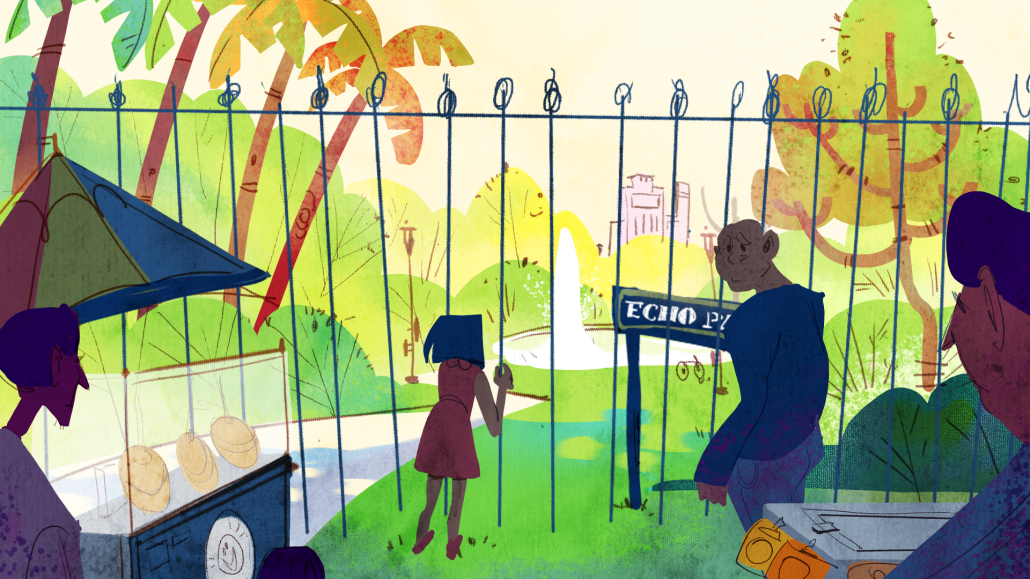Echo Park fence: Transforming residents into outsiders

Pink bougainvillea and pale lotuses grow against the backdrop of vendors’ carts, uniting Echo Park in a floral paradise. The lakefront hosts bounties of geese and ducks that choose to stop by. However, these beautiful colors, animals and the surrounding community were interrupted by a line of silver that surrounded the area for two years — a fence meant to divide and further gentrify a city struggling to care for its unhoused population.
On March 24-25, 2021, the City of Los Angeles, in collaboration with former councilmember Mitch O’Farrell, directed the eviction of the unhoused population around Echo Park Lake. As this population grew in the area, so did the encampments at the lake, allegedly hindering its appeal to the public according to O’Farrell.
Public locales, especially those as attractive as parks, are constantly subject to significant changes in cities where gentrification runs high, affecting nearby communities and businesses such as La Guadalupana, an affordable Latine marketplace in the vicinity. The store was forced to close because of the economic strain of these changes, and its logo now sits faded as a waning reminder of what it once was.
Former councilmember O’Farrell’s claimed “success” of housing residents was nowhere near true; the demographic composition of unhoused individuals in L.A. encampments is disproportionately Black, Indigenous and made up of immigrant communities. Considering these inequalities, it is essential to understand that Echo Park serves as a sanctuary for some of these groups.
As a result of O’Farrell’s claimed “success,” research conducted by the UCLA Luskin Institute on Inequality and Democracy has shown that seven unhoused persons formerly residing in Echo Park have died in connection with the evictions. The causes of death have not been shared. However, because of the eviction, unhoused individuals were occasionally subject to the destruction of their tents, arrest, displacement and as a result, even death.
Depending on who you ask, the fence displays one of two narratives: One, that it evokes cleanliness and a safer park, or two, that its only purpose is to divide already marginalized communities. Those who have lived in and around the neighborhood have lived for decades before without a fence.
On Feb. 2, city Councilmember Hugo Soto-Martinez said he would remove the fence. Following through with his word, the council removed the fence March 27, nearly two years after its initial installation.
For nearly two years, street vendors had to serve the community outside rather than inside the park, which is rightfully their space. High-cost cafes, clothing stores and markets began to erase the diverse culture that migrant populations originally brought to the area. With Huichol earrings, esquites and clothing from Mexico and Guatemala, the street vendors allow for people to remember many cultures in Echo Park. Latine and Asian markets remain boarded up with hope within the community that they will reopen.
Gentrification is on full display in Echo Park, and it comes with the cost of evicting those who reside there, many of whom stay because of solid support from the community members. A fence and security working overnight are not solutions to the unhoused rates, but rather a failure of existing policies. The city must first work on prevention and assisting low-income residents by acknowledging the gentrification.
The attempt to divide the area with a fence rips apart the beauty in Echo Park — from men who play card games by the playground to the excitement of kids wanting to buy a raspado. The banda music that blasts — but no one bothers to ask to tone it down because it is the music of our life — gets drowned out by politics. Slowly, this beauty fades away in the attempts to build dividers within the community.
Soto-Martinez managed to consider the fence’s impact in separating and pinning a united community against each other. Echo Park has only seen doors closing; affordable businesses, family-owned restaurants and street vendors do not deserve to be outside of the space they believed supported them. Residents should not feel like outsiders in their community.
The division among groups is not a solution to preventing unhoused rates; therefore, the fence is not a solution but rather pushes the issue outside. The changes to Echo Park’s beauty are unnecessary; culture must remain, flowers must continue to grow and street vendors must re-obtain the grounds that were once theirs.

